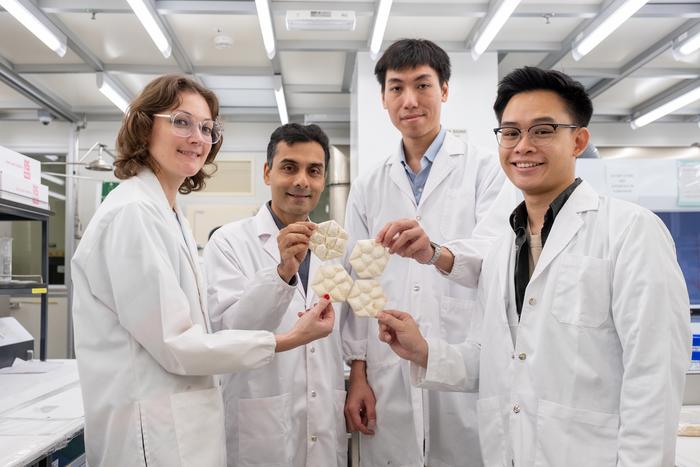Scientists at Nanyang Technological University (NTU) Singapore have pioneered a groundbreaking innovation with the development of ‘fungi tiles’—a novel building material designed to mitigate heat and enhance energy efficiency in a sustainable manner. This cutting-edge material ingeniously combines mycelium, the root network of fungi, with organic waste, presenting a promising alternative to traditional thermal insulation products. The need for effective insulation is particularly pressing, given that the construction industry accounts for a staggering 40 percent of global energy-related emissions. Consequently, the search for eco-friendly building materials has become increasingly critical.
Building upon previous research indicating that mycelium-based composites exhibit superior insulating properties compared to conventional materials such as expanded vermiculite and lightweight clay aggregates, the NTU research team, in collaboration with bioSEA—an ecology and biomimicry design firm—augmented the functional attributes of these tiles. By incorporating a bumpy, textured design inspired by elephant skin, they engineered a tile that embodies both functionality and a unique aesthetic. Elephants, which survive without sweat glands, have developed an evolutionary advantage through the wrinkles on their skin. These features enhance their ability to regulate body temperature through increased surface area for evaporative cooling.
In laboratory tests, the mycelium tiles inspired by elephant skin demonstrated a remarkable 25 percent better cooling rate than their flat counterparts. Furthermore, they exhibited a 2 percent reduction in heating rate, showcasing their efficiency under varying environmental conditions. Notably, the performance improved dramatically under simulated rainfall, achieving a further 70 percent enhancement in cooling efficiency. This makes the tiles particularly suitable for tropical climates, where high temperatures and humidity levels are prevalent.
The leading researcher, Associate Professor Hortense Le Ferrand, expressed the potential of these mycelium-based composites as a game-changing insulation solution. Traditional insulation materials are predominantly synthetic, leading to significant environmental consequences through their lifecycle. In contrast, mycelium-based composites offer a biodegradable, porous alternative, demonstrating thermal conductivity on par with or superior to that of current synthetic materials commonly used in construction.
Collaborating with bioSEA, the team adopted natural design principles to increase the tiles’ performance. The innovative results of this collaboration stand as a proof of concept towards achieving efficient, sustainable, and cost-effective passive cooling solutions in building design. Dr. Anuj Jain, founder of bioSEA, elaborated on the inspiration drawn from elephants. He emphasized how understanding the organism’s natural cooling mechanisms—such as shading and the ability to retain water—has informed the design of these cutting-edge tiles.
The research study detailing these developments, published in the journal Energy & Buildings, reinforces the potential of mycelium-bound composites for greener construction practices. They are created through a method where fungi are cultivated on organic materials, resulting in a solid, porous composite capable of effective thermal insulation. In this investigation, oyster mushroom mycelium was used in combination with bamboo shavings, demonstrating the versatility of sustainable materials sourced from waste products.
To replicate the elephant skin texture, the scientists used computational modeling and innovative algorithms to design a hexagonal mold. Following two weeks of growth in dark conditions, the mycelium tiles underwent a drying process to eliminate moisture and prevent further fungal growth, resulting in a stable yet functional product. The resultant tiles possess the inherent properties necessary for energy-efficient insulation, coupling sustainability with practicality.
Subsequent tests explored the influence of the textured design on heat regulation within the tiles. Through controlled heating experiments on a hot plate, the researchers discovered that the bumpy surface of the tiles significantly mitigated heat absorption, thereby enhancing their thermal performance. The textured tiles lost heat more slowly than their flat counterparts, indicating their efficacy in temperature regulation when applied in real-world scenarios.
Furthermore, the innovative design exhibited exceptional cooling efficiency even in wet conditions. Through experiments simulating rainfall, the bumpy tiles demonstrated drastic improvements, emphasizing the hydrophobic properties of the mycelium-bound composite. This phenomenon occurs due to the unique fungal skin that forms on the tiles, which facilitates the retention of moisture and fosters evapotranspiration, thereby optimizing cooling rates in humid environments.
Looking to the future, the research team is committed to refining these fungi tiles for practical applications, emphasizing enhancements in mechanical stability and durability. The scientific community recognizes that scaling up production remains a challenge due to the slow growth cycle of mycelium, which spans several weeks. However, ongoing collaborations with local start-up companies aim to address these obstacles by testing larger tiles and exploring outdoor applications.
Concerns regarding the inertia towards adopting mycelium tiles in modern construction remain valid. Established infrastructures for traditional insulating materials pose a significant barrier to entry for innovative alternatives. Nevertheless, Associate Professor Le Ferrand reiterated the potential impact of these tiles, emphasizing their ability to transform agricultural waste into valuable resources while promoting sustainable innovation in building design.
In summary, the advent of fungi tiles represents a new frontier in sustainable construction, promising to enhance energy efficiency and reduce the ecological footprint of the construction industry. This creative endeavor not only addresses pressing environmental concerns but also reflects a growing trend towards integrating natural principles into architectural practices. The potential for further development of similar environmentally friendly materials looks promising as research efforts continue to evolve, paving the way for a greener future.
Subject of Research: Development of eco-friendly fungi tiles for building insulation
Article Title: Innovative Fungi Tiles Inspired by Elephants Revolutionize Building Insulation
News Publication Date: October 2023
Web References: National University of Singapore
References: Thermal insulation and energy performance assessment of a mycelium-based composite wall for sustainable buildings
Image Credits: NTU Singapore
Keywords: mycelium composites, sustainable building materials, energy-efficient insulation, elephant-inspired design, biodegradable materials, thermal conductivity




